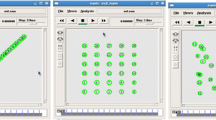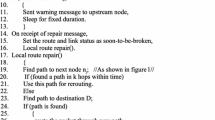Abstract
When evaluating the performance of routing protocols in wireless mesh network (WMN), we need deeper analysis from the aspect of network traffic complexity to show how traffic characteristics are influenced by routing protocols and node mobility. The predictability of network traffic can be used as one metric of complexity and can be analyzed by multi-scale entropy (MSE) method. With 20 different random waypoint (RWP) mobility scenarios and with destination sequenced distance vector (DSDV), a typical proactive protocol, and Ad hoc on-demand distance vector (AODV), a typical reactive protocol, the predictabilities of aggregated traffic of gateway in WMN are analyzed using MSE method to show how different routing protocols bear different mobility scenarios. The MSE results show that the aggregated traffic of gateway with DSDV is more difficult to be predicted than that with AODV for different mobility scenarios. The maxspeed parameter of RWP dominates the traffic predictability for AODV. Both of the pause time and the maxspeed parameters, have great influence on the traffic predictability for DSDV. The reasons lie in the behaviors of routing protocols, i.e., AODV has up-to-date paths while DSDV does not.





Similar content being viewed by others
References
Boukerche, A. (2004). Performance evaluation of routing protocols for ad hoc wireless networks. Mobile Networks and Applications, 9(4), 333–342.
Perkins, C. E., & Bhagwat, P. (1994). Highly dynamic destination-sequenced distance-vector routing (DSDV) for mobile computers. In Proceedings of the conference on communications architectures, protocols and applications (pp. 234–244).
Perkins, C. E., Royer, E. M., & Das, S. R. (2003). Ad hoc on-demand distance vector (AODV) routing. Accessed September 15, 2013, from http://www.rfc-editor.org/rfc/rfc3561.txt.
Ren, W., Yeung, D. Y., & Jin, H. (2006). TCP performance evaluation over AODV and DSDV in RW and SN mobility models. Journal of Zhejiang University: Science A, 7(10), 1683–1689.
Feng, H. F., & Xu, Y. J. (2013). Multifractal detrended fluctuation analysis of WLAN traffic. Wireless Personal Communications, 66(2), 385–395.
Wu, Y. L., Min, G. Y., & Yang, L. T. (2013). Performance analysis of hybrid wireless networks under bursty and correlated traffic. IEEE Transactions on Vehicular Technology, 62(1), 449–454.
Abry, P., Baraniuk, R., Flandrin, P., Riedi, R., & Veitch, D. (2002). Multiscale nature of network traffic. IEEE Signal Processing Magazine, 19(3), 28–46.
Chen, Y. F., Xiang, Z. T., Dong, Y. B., & Lu, D. M. (2011). Multi-fractal characteristics of mobile node’s traffic in wireless mesh network with AODV and DSDV routing protocols. Wireless Personal Communications, 58(4), 741–757.
Vasalos, I., Carrasco, R. A., Woo, W. L., & Soto, I. (2008). Nonlinear complex behaviour of TCP in UMTS networks and performance analysis. IET Circuits Devices and Systems, 2(1), 69–79.
Vasalos, I., & Carrasco, R. A. (2008). Dynamic complexity of TCP in UMTS networks and performance evaluation. In Proceedings of 4th international conference on wireless and mobile communications (pp. 253–259).
Feng, H. F., Shu, Y. T., & Yang, O. W. W. (2011). Research on characterization of wireless LANs traffic. Communications in Nonlinear Science and Numerical Simulation, 16(8), 3179–3187.
Costa, M., Goldberger, A. L., & Peng, C. K. (2005). Multiscale entropy analysis of biological signals. Physical Review E, 71(2), 021906.
Riihijarvi, J., Wellens, M., & Mahonen, P. (2009). Measuring complexity and predictability in networks with multiscale entropy analysis. In Proceedings of IEEE international conference on computer communications (pp. 1107–1115).
Costa, M., Goldberger, A. L., & Peng, C. K. (2002). Multiscale entropy analysis of complex physiologic time series. Physical Review Letters, 89(6), 068102.
Riihijarvi, J., Mahonen, P., & Wellens, M. (2008). Metrics for characterizing complexity of network traffic. In Proceedings of international conference on telecommunications (pp. 1–6).
Petkov, V., Rajagopal, R., & Obraczka, K. (2013). Characterizing per-application network traffic using entropy. ACM Transactions on Modeling and Computer Simulation, 23(2), 14.
Prasad, P. S., & Agrawal, P. (2010). Effect of mobility prediction on resource utilization in wireless networks. In Proceedings of IEEE wireless communications and networking conference (pp. 1–6).
Wang, Q. S., Wang, X. B., & Lin, X. J. (2009). Mobility increases the connectivity of K-hop clustered wireless networks. In Proceedings of 15th annual ACM international conference on mobile computing and networking (pp. 121–132).
Camp, T., Boleng, J., & Davies, V. (2002). A survey of mobility models for ad hoc network research. Wireless Communications and Mobile Computing, 2(5), 483–502.
Pincus, S. M. (1991). Approximate entropy as a measure of system-complexity. Proceedings of the National Academy of Sciences of the USA, 88(6), 2297–2301.
Richman, J. S., & Moorman, J. R. (2000). Physiological time-series analysis using approximate entropy and sample entropy. American Journal of Physiology-Heart and Circulatory Physiology, 278(6), 2039–2049.
VINT Project. (2008). The NS manual. Accessed August 22, 2009, from http://www.isi.edu/nsnam/ns/doc/ns_doc.pdf.
Hamidian, A. (2003). A study of Internet connectivity for mobile ad hoc networks in NS 2. M.S. thesis, Lund Institute of Technology, Sweden.
Nagel, K., & Schreckenberg, M. (1992). A cellular automaton model for freeway traffic. Journal De Physique I, 2(12), 2211–2229.
Kerner, B. S., Klenov, S. L., & Wolf, D. E. (2002). Cellular automata approach to three-phase traffic theory. Journal of Physics A, 35(47), 9971–10013.
Acknowledgments
Projects supported by the National High-Tech R&D Program (863) of China (No. 2012AA101701), the Key Program of the Natural Science Foundation of Hubei Province of China (No. 2013CFA054), the Key Science and Technology Program of Hubei Provincial Department of Education (No. D20141804), Intelligent Driving Control Key Laboratory of Hubei Province (Hubei University of Automotive Technology) (No. ZDK2201403), and the Shanghai Planning Project of Philosophy and Social Science (No. 2011BTQ001).
Author information
Authors and Affiliations
Corresponding author
Rights and permissions
About this article
Cite this article
Xiang, Z., Chen, Y., Li, Y. et al. Predictability of Aggregated Traffic of Gateways in Wireless Mesh Network with AODV and DSDV Routing Protocols and RWP Mobility Model. Wireless Pers Commun 79, 891–906 (2014). https://doi.org/10.1007/s11277-014-1893-x
Published:
Issue Date:
DOI: https://doi.org/10.1007/s11277-014-1893-x




